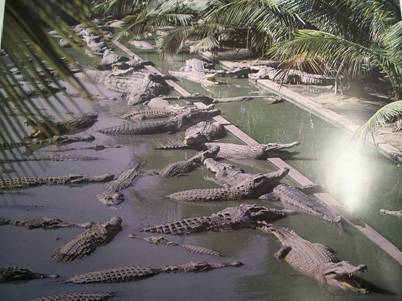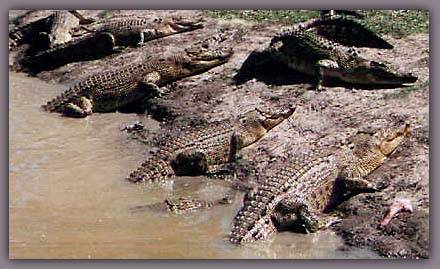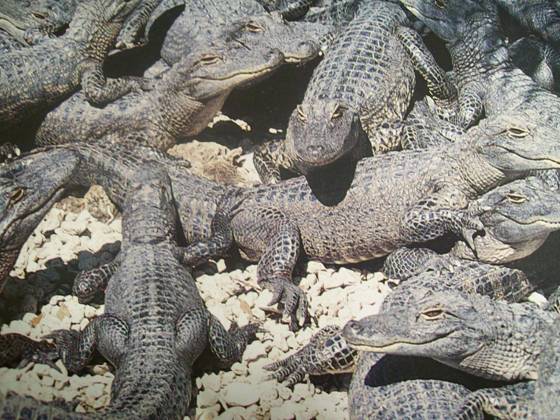
Articles
Alligator Farms
Characteristics
Conservation
Diet
Facts
Reproduction
Safety
Crocodiles and Alligator Farms
Crocodile and alligator farms have been in existence since the early twentieth century. However, these early “farms” were similar to zoological parks that specialized in exhibiting crocodilians. There was no emphasis on breeding crocodilian stock and the primary source of income was tourism. These operations had little effect on utilization, conservation, or knowledge of crocodilians.
In the early 1960s, the wild crocodilian resource necessary for the skin trade had dwindled and the first conservation laws were enacted, resulting in a simultaneous rise in prices and in the demand for skins. It was at this time that farsighted conservationists and skin producers started to investigate the feasibility of farming and ranching crocodilians on a sustained, commercial basis.


Purpose of Farms and Ranches
The term “crocodile farm” is often used to describe any facility __ ranch or farm __raising crocodiles for commercial purposes. However, “farm” is the term more correctly used for a closed crocodile – farming system where all the stock marketed must be bred on the farm or from captive – bred sources. Once established, the only (occasional) outside input is breeding stock to maintain genetic viability.
Conservation and educational farms (often called banks or rehabilitation projects) aim at breeding endangered species of crocodilians in captivity for possible release back into protected areas in the wild. Primary income comes from tourism and / or grants from local government and conservationists, not from the sale of skins. Unlike the earlier tourist – trap “farms,” these operations can supply the public with up – to – date information on conservation and natural history. Many zoological parks now fall into this category as there is an emphasis on accumulating breeding groups of crocodilians rather than “ postage – stamp collections” of individuals from a number of species for exhibits. Other farms, which received original stock from a variety of sources but which, through captive breeding, have a closed, sustained system for supplying skins to the trade, derive their primary income from skin sales to the trade, although they may also derive some income from tourism.
The term “ranch “ is used where crocodilian stock --eggs, hatchlings, or adults - are taken from the wild on an annual basis and raised for market.
There are two major categories of ranch. Rearing stations, where eggs or juvenile crocodilians are collected from the wild and reared to skinning size, derive their income from the sale of skins and possibly tourism. Other ranches are dependent on taking crocodilians of marketable size from the wild as well as juveniles and eggs for rearing. Their emphasis is on management of habitat for sustained – yield harvesting. (Management of habitat may serve multiple purposes ___ cropping of fur – bearing animals, birds, and other marsh or swamp dwellers as well as harvesting of building materials, and food from plants.) Tourism is not a source of income.
Commercial development and international trade in endangered species such as crocodiles must satisfy the criteria of the convention on International Trade in Endangered Species of Fauna and Flora ( CITES). Commercial farms must be able to demonstrate a viable second generation progeny for the species. Ranching programs must operate under an Approved Management plan that must demonstrate, for a defined geographic area, that the impact of harvesting is not detrimental to the species.

Alligator Farming In the United States
The bequest of coastal Louisiana marshlands to government land and wildlife management agencies by E. A. Mcllhenny (author of The Alligator’s Life History and founder of the Mcllhenney Tabasco sauce Company) earlier this century had a major impact on the conservation, management, and ultimately the development of crocodilian farming technology.
Mcllhenny required that all revenue generated from the bequeathed lands must be reinvested in them, and to satisfy this provison the Wild Life and Fisheries Commission of the State of Louisiana assumed management control of the bequeathed lands. On part of these lands, Rockefeller Wildlife Refuge was created. The Refuge is rich in oil and, under careful management; this resource was tapped and has provided a steady source of revenue for the Refuge and ancillary projects. Using these funds, the commission initiated a pioneer program of alligator management in the early 1960s.
The primary aim of the commission was to conserve the wetlands habitat of Louisiana. One method of doing this was to crop, on a sustained – yield basis, fur – bearing mammals, waterfowl, and alligators. It was hoped that this revenue, coupled with tax incentives and other government grants, would make income from managed marshlands competitive with agricultural development. In effect, the entire coastal marsh habit of Louisiana was to become a giant alligator ranch.
Under the United States Endangered Species Act of 1969, the American Alligator (Alligator mississippiensis) became a federal responsibility. Management of the species was under the control of the United States Fish and Wildlife service.
Although the State of Louisiana and the Fish and Wildlife Service may have had the same ultimate goal _ preservation of the alligator _ their methods differed and a historic “state’s rights” battle ensued. During this time, cropping of wild, ranched alligators was not possible and research at Rockefeller Refuge turned more toward rearing and farming of alligators in captivity.
Early research at Rockefeller Wildlife Refuge included penning wild – taken alligators in native marsh habitat to determine the optimum pen size, feeding routine and the effect of diet on fertility of eggs, water- land relationship, and sex – stocking ratios required for maximum production of eggs. Subsequently the staff developed methods for the collection and incubation of eggs, hatching, and rearing hatchlings to optimum skinning size. This require research into optimum diet for hatchlings, temperature – dependent sex ratios, the causes of malformations, and bacteriological and disease prophylaxis. The results of this Rockefeller Refuge – based research, modified for local conditions, have been used by farms worldwide.
Current farming research in Louisiana includes rearing alligators in controlled environments for maximum commercial advantage. In effect, alligators are reared in hothouses with heated water and a steady source of food. Music, preferably Cajun, is piped into the chambers and this evidently decreases the trauma to the alligators from external disturbances such as the cleaning of pens. Under these conditions, a commercially useful alligator or more than 1 meter (3.3 feet) in length can be produced in one year.
It was found that maintenance and nesting of “domestic” alligators (those reared in captivity) was more economical than using wild – taken or nuisance alligators. In addition, domestic alligators reared in environmental chambers nested at a young age _6 years as opposed to 10 years for wild Louisiana alligators _ and, if fed properly and stocked at the right density, eventually produced more nests than wild alligators. Clutch size increased with the age of the nesting female. The incubation temperature of eggs was found to influence post – hatching growth, with an incubation temperature of 31.7 C. (89 F) producing the lowest number of runts and the overall best growth rates.
Alligator farms in Louisiana have to be licensed by the commission. There are a variety of factors that influence licensing but a prerequisite is the use of environmental – control chambers. Research at Rockefeller Refuge has shown that commercially valuable skins can be produced economically by farms using current knowledge and there are now 13 established farms holding some 21,000 captive alligators in the State. The economic feasibility of rearing alligators in hothouses for maximum growth has been established only for animals up to the minimum sizes required by the skin trade. For larger alligators cropping of the wild, ranched population is still necessary.
Both Louisiana and Florida have a controlled, limited season for taking alligators and are attempting to manage their wild populations. The Louisiana strategy of managing and conserving alligator habitat by making it economical to ranch marshlands may, in the end, not only support the crocodilian skin trade by providing size classes of alligators not available from farms but also provide refuge and living space for all the native and migrant wildlife that utilizes these lands.
American Alligators have been farmed for many years but the conditions under which they were maintained in the past, where maintained in the past, were subject to few imposed standards. Alligator farms today use modern technology to raise commercially valuable animals in sanitary conditions.